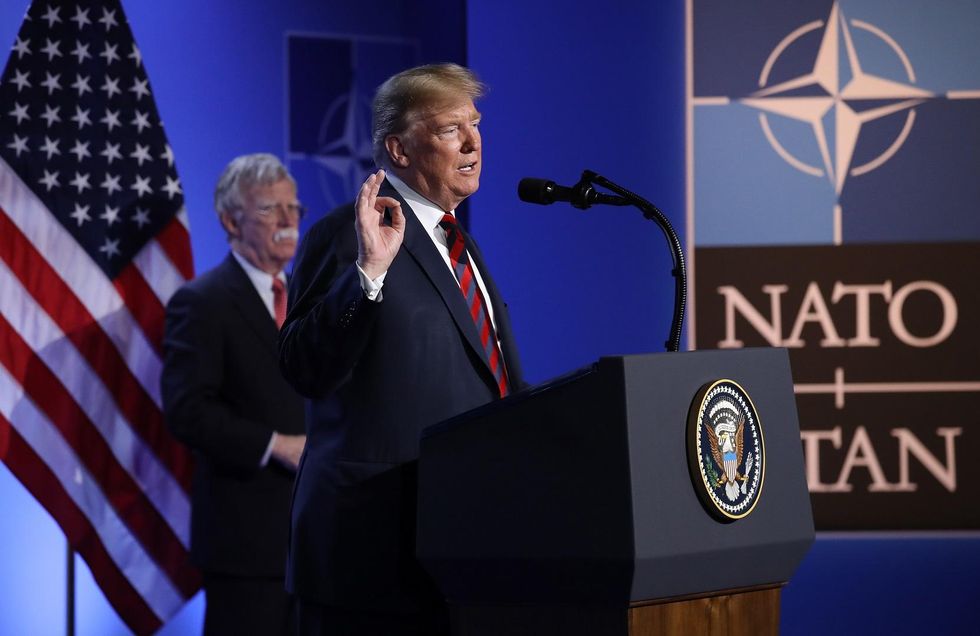EDITOR'S NOTE: An earlier version of this story stated that the president cannot withdraw the United States from the North Atlantic Treaty without Senate approval. This was based on reports from other news outlets. However, after further research we discovered that this was not the case. The story has been updated to show that while it would in fact be legal for the president to do so, it would be largely unprecedented.
After meeting with NATO allies, President Donald Trump took credit for the other NATO members agreeing to increase their national defense spending to 2 percent of their respective GDPs.
However, French President Emmanuel Macron insisted that the amount they agreed to at this summit had already been agreed to in 2006 and the deadline for reaching this goal had been decided in 2014 — before Trump had even announced his candidacy.
What did President Trump say?
“NATO is much stronger now than it was two days ago,” Trump told reporters on Thursday, after an unscheduled meeting of NATO members. “Yesterday, I let them know that I was extremely unhappy with what was happening and they have substantially upped their commitment and now we're very happy, and have a very, very powerful, very strong NATO; much stronger than it was two days ago.”
Macron contradicted this statement, saying that the only agreement was to keep the target spending levels at the same percentage to which the members of the alliance had already agreed to years ago.
How much is each country spending?
The 2 percent amount refers to the amount each nation spends on its own defense, not specifically NATO. A much smaller amount from each nation goes toward funding NATO directly. When it comes to direct spending of NATO, the U.S. contributes the most (roughly 22 percent of the total amount), while Germany comes in second (roughly 15 percent).
In 2006, during the Bush administration, NATO members agreed to spend 2 percent of their respective gross domestic products on their own defense. However, at this point no deadline for reaching this goal was set.
In 2014, during the Obama administration, this was clarified, and a nonbinding guideline of 2024 was set. This was in response to Russian aggression in Ukraine. In addition to the U.S., four other NATO members have already reached this goal: Greece, Estonia, the United Kingdom, and Poland.
According to the text of the 2014 declaration, “Allies whose current proportion of GDP spent on defence is below this level will ... aim to move towards the two percent guideline within a decade with a view to meeting their NATO Capability Targets and filling NATO's capability shortfalls.”
On Wednesday, Trump tweeted that the allies must reach the 2 percent target “IMMEDIATELY, not by 2025.”
During a news conference on Thursday, Trump said that the final level would end up being “quite a bit higher” than 2 percent:
Only five of 29 countries were making their committment, and that's now changed. The commitment was at 2 percent, ultimately it will be going up quite a bit higher than that. So we are — we made a tremendous amount of progress today. It's been about, at a minimum, they estimate, and they're going to be giving you exact numbers, but since last year they've raised an additional $33 billion dollars that's been put up by the various countries, not including the United States.
Trump said it was “really amazing to see” the “level of spirit” in the room and how much money the other members were willing to spend.
However, on Thursday Macron insisted that the alliance had only reiterated that it would reach these 2 percent spending numbers.
“There is a communiqué that was published yesterday. It's very detailed,” Macron reportedly said. “It confirms the goal of 2 percent by 2024. That's all.”
What else?
Trump has frequently criticized the NATO alliance. In a tweet he asked “what good” NATO was.
Some news outlets, including Reuters, reported that Trump had threatened to pull the United States out of the alliance if NATO members did not increase their spending by January. However, the Associated Press reported that Macron had said that Trump “never at any moment, either in public or in private, threatened to withdraw from NATO.”
Even if Trump did decide to pull the United States out of NATO, it is unlikely that he would do so without Senate approval. While the Constitution does not specifically say that the Senate must approve a treaty withdrawal, it would be nearly unprecedented for a president to do so without consulting the Senate first.
Trump isn't the first world leader to threaten to withdraw from NATO. French President Charles de Gaulle pulled his nation's military resources out of the alliance in 1966. Although its withdrawal was largely symbolic, and it was always still a part of the broader NATO alliance, France wasn't reinstated as a full member until 2009.
Remind me again...what is NATO?
The North Atlantic Treaty Organization is an alliance of western nations, which was formed in 1949 to protect against the growing threat of the Soviet Union following the end of World War II. Article 5 of the North Atlantic treaty states that an attack on any member nation will be viewed as an attack on all member nations.
Article 5 has only been invoked once: by the United States after the Sept. 11 attacks in 2001.




